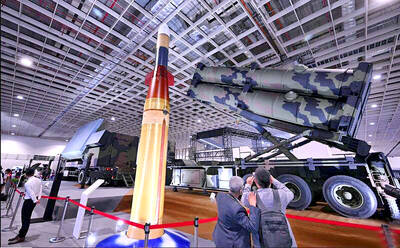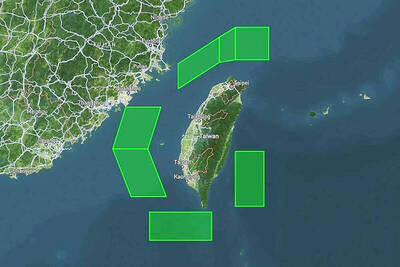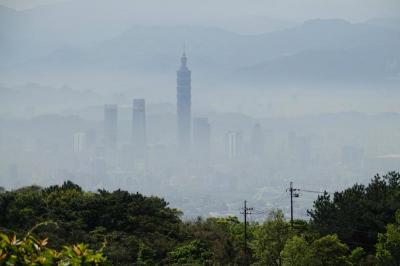The timing for the release of the movie An Inconvenient Truth in Taiwan last month could not have been better -- in September the Executive Yuan approved a draft bill designed to reduce greenhouse gas emissions and the Environmental Protection Administration (EPA) was just about to sign a declaration with seven countries from Central America to commit to emissions cuts.
The compelling evidence on climate change presented by former US vice president Al Gore also came as a solid endorsement for the three Taiwan Green Party candidates running for the Taipei City Council, who are campaigning on the greenhouse gas issue.
Despite some progress, environmental activists suggest that more needs to be done to reduce carbon emissions.
Wu Tung-jye (
Wu noted that the Cabinet needs to consider the issue from a much broader perspective, including whether it is necessary for the nation to construct another freeway or to build another steel or petrochemical plant.
The idea of a specific timeline, however, was rejected by the EPA officials.
"Only laymen would come up with a proposal like that," said Young Chea-yuan (楊之遠), director-general of the EPA's air quality protection and noise control department, adding that the timeline for the Kyoto Protocol was arrived at through multiple rounds of negotiations and compromises among the signatories.
Young said the protocol was signed by 38 industrialized countries around the world. And realizing that strict observance of the protocol would not be easy, industrialized countries have agreed on several viable solutions to help them meet the emission targets.
Young said countries can actually increase their quota of greenhouse gas emissions through the Clean Development Mechanism, where more developed countries help less developed ones curb the amount of greenhouse gas they produce.
"Taiwan can by no means be categorized as an industrialized country, and it is neither a member of the United Nations nor a signatory of the protocol," Young said. "We are unable to do this kind of trading with any country in the international community."
Young said the law is "a very serious thing," and it might involve an overhaul of the nation's energy policy.
Young also said that unlike the nation's air pollution laws, where the EPA is granted complete executive authority, the administration needs to coordinate with other departments in Cabinet, such as Ministry of Economic Affairs, to reduce carbon emissions. It also needs to convey the government's policy objectives to private industry, he said.
The lack of consensus on what the law could achieve is not the only hurdle.
Minister of the Environmental Protection Agency Chang Kow-lung (張國龍) said in a press conference held at the beginning of this month that the nation should dedicate at least 1 percent of GNP to reducing greenhouse gas emissions, but the budget that was assigned to the EPA only accounts for about 0.5 percent of GNP.
This sum is supposed to cover all the environmental conservation work required, he said.
Industries, on the other hand, have ambivalent feelings about the policy to reduce carbon emissions, given that Taiwan is not a signatory of the protocol.
British Trade and Cultural Office Director Michael Reilly said that climate change is simply an issue that industry cannot ignore any more.
"Because climate change will affect all of us. And it will affect our children even more. None of us can solve it on our own," Reilly said.
According to Reilly, the British government has taken practical steps to tackle the issue of greenhouse emissions.
The most significant measure was the introduction of the climate change levy, which was first announced in 1999 but formally introduced in 2001.

Taiwan is to commence mass production of the Tien Kung (天弓, “Sky Bow”) III, IV and V missiles by the second quarter of this year if the legislature approves the government’s NT$1.25 trillion (US$39.78 billion) special defense budget, an official said yesterday. Commenting on condition of anonymity, a defense official with knowledge of the matter said that the advanced systems are expected to provide crucial capabilities against ballistic and cruise missiles for the proposed “T-Dome,” an advanced, multi-layered air defense network. The Tien Kung III is an air defense missile with a maximum interception altitude of 35km. The Tien Kung IV and V

The disruption of 941 flights in and out of Taiwan due to China’s large-scale military exercises was no accident, but rather the result of a “quasi-blockade” used to simulate creating the air and sea routes needed for an amphibious landing, a military expert said. The disruptions occurred on Tuesday and lasted about 10 hours as China conducted live-fire drills in the Taiwan Strait. The Civil Aviation Administration (CAA) said the exercises affected 857 international flights and 84 domestic flights, affecting more than 100,000 travelers. Su Tzu-yun (蘇紫雲), a research fellow at the government-sponsored Institute for National Defense and Security Research, said the air

A strong continental cold air mass is to bring pollutants to Taiwan from tomorrow, the Ministry of Environment said today, as it issued an “orange” air quality alert for most of the country. All of Taiwan except for Hualien and Taitung counties is to be under an “orange” air quality alert tomorrow, indicating air quality that is unhealthy for sensitive groups. In China, areas from Shandong to Shanghai have been enveloped in haze since Saturday, the ministry said in a news release. Yesterday, hourly concentrations of PM2.5 in these areas ranged from 65 to 160 micrograms per cubic meter (mg/m³), and pollutants were

Taiwan’s armed forces have established response protocols for a wide range of sudden contingencies, including the “Wan Chun Plan” to protect the head of state, the Ministry of Defense (MND) said today. After US President Donald Trump on Saturday launched a series of airstrikes in Venezuela and kidnapped Venezuelan President Nicolas Maduro, concerns have been raised as to whether China would launch a similar “decapitation strike” on Taiwan. The armed forces regularly coordinate with relevant agencies and practice drills to ensure preparedness for a wide range of scenarios, Vice Minister of National Defense Hsu Szu-chien (徐斯儉) told reporters before a